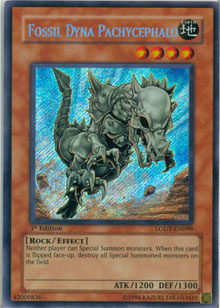Today we’ll be looking at a deck that aims to do two things: change the way the Yu-Gi-Oh! TCG is played and demonstrate the advantage of creating dead cards in your opponent’s hand. If you have time to test this deck, or at least some version of it, you’ll be surprised at how easily a metagame is broken and the most powerful decks and cards are thwarted. This strategy might also be useful as a transitional deck for casual players looking to advance to a local (or possibly regional) tournament level, as it is rather inexpensive to build and there are tips for cutting the price tag drastically. More than anything, this deck is going to be used as an instructional tool to easily demonstrate gaming theory, although it’s more than good enough to disassemble a heavily focused metagame.
This deck is primarily composed of two types of cards: monsters that inhibit special summoning and cards meant to keep those monsters alive while clearing the field. This means both you and your opponent are bringing your dueling back to the basics. The game has long since evolved from playing a monster, destroying your opponent’s monster, and attacking. We now play a game in which monsters represent monster removal, spells and traps represent drawing power, and combos run wild. Very few decks are focused on simply playing a monster and maintaining field presence with it via spells and traps. As a result, most strategies use the synergy between cards to fulfill requirements for monster removal, damage, and defense. However, if you can throw a proverbial wrench into that synergy—making it ineffective—you can turn your opponent’s deck into a collection of useless cards.
That is the theory of anti-meta decks.
The Monsters
 The monster lineup might as well be fifteen copies of the same monsters. If you don’t have three copies of Fossil Dyna Pachycephalo handy (they aren’t the cheapest of cards), you can replace them with three copies of Barrier Statue of the Stormwinds. While the Barrier Statues are vastly inferior to the little Fossil, they’re more than powerful enough to get the job done.
The monster lineup might as well be fifteen copies of the same monsters. If you don’t have three copies of Fossil Dyna Pachycephalo handy (they aren’t the cheapest of cards), you can replace them with three copies of Barrier Statue of the Stormwinds. While the Barrier Statues are vastly inferior to the little Fossil, they’re more than powerful enough to get the job done.
The power of running these instead of simply playing a Gadget deck featuring Royal Oppression is that your combos are incredibly consistent. Your entire deck is basically two cards: a Barrier Statue and a giant Sakuretsu Armor.
The Spells
The spell lineup has only one "off" card: Heavy Storm. Other than that, everything is monster removal.
This means that our Barrier Statues are going to have a much easier time surviving and slowly eating at our opponent’s life points. It’s the deck’s consistency that makes it powerful, and the deep focus of the spell lineup is an expression of that fact.
However, it has to be noted that within the variety of monster destruction cards there are several divisions. The first, and most important, is the ability to play the card during your opponent’s turn. If it isn’t a quick-play spell it won’t save your Barrier Statue: it’ll only clear the way for the next one. This means that if you have the choice to play Smashing Ground or Shrink during your own turn, you should almost always save the Shrink to play on your opponent’s.
We also have monster destruction for defense-position monsters. If your opponent is playing a Monarch deck, you’ll need a way to get past all those walls that can so easily turn into tribute fodder. Cards like Nobleman and Shield Crush give you the chance to do that.
The Traps
The trap lineup is very similar to the spell lineup, and contains mostly monster destruction. The only off-theme card here is Solemn Judgment, which will guard you from Heavy Storm.
Both Solemn Judgment and Mirror Force are expensive cards, but you might already have them if you’re a tournament player. If you don’t, you might want to consider replacing the three copies of Solemn with three copies of My Body as a Shield. This will help guard your Barriers from cards like opposing copies of Mirror Force and Torrential Tribute, which encompasses a majority of the times you’ll want to play Solemn Judgment with this deck. It’s basically the same card most of the time. Mirror Force is an overpowered monster destruction card: if you don’t have access to that, you can replace it with another chainable monster destruction card.
When playing this deck, try to name the cards in your opponent’s hand. Playing anti-meta decks and generating dead cards in your opponent’s hand really helps you read your opponents, and gives you a much better insight into play choices according to your reads. This is probably the most important skill set for a strong player, so any exercise that can help you improve your reads is worth trying. You’ll also be surprised to see how quickly a deck can fall apart when your opponent’s Gladiator Beast or Teleport Dark Armed Dragon deck slows to a halt. This will benefit your deckbuilding skills and give you a more accurate in-play assessment of what your opponents’ weaknesses, fears, and hand contents most likely are.
Good luck, and enjoy raising your skill level another touch by testing!
—Ryan Murphy